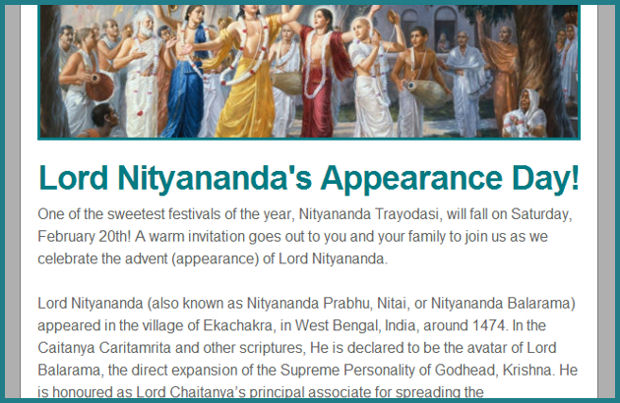Wednesday, January 27th 2016
Tuesday, January 26th 2016
→ The Walking Monk
Longdenville,
Monday, January 25th 2016
→ The Walking Monk
Sunday, January 24th 2016
→ The Walking Monk
Actually, the illusions of the world are something to be concerned about; hence we need protection - a spiritual protection. When we don’t obtain protection we become most vulnerable.
View Our Monthly Newsletter – February 2016
→ The Toronto Hare Krishna Temple!
Remember, you can receive our monthly newsletter right in your inbox by clicking here to sign up, or by using the sign up form on the right hand side of this page! Hare Krsna!
Saturday, January 23rd, 2016
→ The Walking Monk
Zoom! They’re gone behind the sign
White letters pointing to the long white line
And I’m going to the country
Oh la la la la la la
I’m going to the country
Sunshine smile on me
I can smell the grass growing in the field
Wind in my hair tells me how it feels
Farm houses, silver roof flashing by
Tractor – trailer truck says goodbye with a sigh
And I’m going to the country
Oh la la la la la la
I’m going to the country
Sunshine smile on me
Birds singing, I’m singing in my bones
Doesn’t much matter now where I’m going
Get it when I get there is what I’ll do
If I get enough I’ll give some to you
And I’m going to the country
Oh happy as can be
I’m going to the country
Sunshine smile on me
Friday, January 22nd, 2016
→ The Walking Monk
If you are going to go on pilgrimage to
Thursday, January 21st, 2016
→ The Walking Monk
Toronto, Ontario
The Traffic Moved
The traffic moved ever so slow
On Bloor through the sprinkled snow.
The usual passion did not show
Like a lazy ball with little “go”.
Mandala and I moved quite fast
To combat the chilled Arctic blast.
The traffic we seemed to go right past,
Our feet fueled and totally gassed.
Shoppers are few in the January blues.
Christmas is gone, its lights blew a fuse.
It’s that timely circle, no new news.
In the glum of it, there’s debts and dues.
We were quite glad, stepping the street,
Venting the power of our body heat.
You measure life by strides on the feet,
Making each move neat and complete.
We stopped to visit our tattoo friend
Working hard and that to no end.
Ten minutes went, that time we did spend
Till it came time to go round the bend.
It was night, the day said “Closed!”
All seemed still, perfectly posed.
We arrived home, I showered and hosed.
I read and wrote, then finally dozed.
May the Source be with you!
7 km
Siva, Krsna, Guru, and Sisya
→ Dandavats
 By Giriraj Swami
By Giriraj Swami Why is Lord Shiva considered the greatest Vaishnava? Because he is always absorbed in thought of Vasudeva (Krishna). The state in which one can always be absorbed in Krishna consciousness, in thought of Vasudeva, is called vasudeva, or suddha-sattva, a state transcendental to the material modes of nature. When one is completely freed from the influence of material nature, he comes to the stage of suddha-sattva, or vasudeva, in which Vasudeva, or Krishna, is revealed. Vasudeva is also the name of Krishna’s father, and in a very literal, transcendental way Krishna (Vasudeva) appears from His father (Vasudeva). This fact is explained, and elaborated on, in a profound purport by Srila Prabhupada, in the Tenth Canto of Srimad-Bhagavatam, Chapter Two: “Prayers by the Demigods to Krsna in the Womb.” Continue reading "Siva, Krsna, Guru, and Sisya
→ Dandavats"
Harinamas in Allahabad, India (33 min video)
Sri…
→ Dandavats

Harinamas in Allahabad, India (33 min video)
Sri Sacitanayastakam: I salute the Son of Mother Saci, Whose heart is in a state of rapture, transformed by feelings of intense love. In His pastime of loud roaring, before the mischievous and malicious rascals, He removes all fear of the vast ocean of material existence, by the effect of His unlimited compassion.
Watch it here: https://goo.gl/19isOf
Preaching program in Zurich (Album with photos)
Kurma Dasa: A…
→ Dandavats

Preaching program in Zurich (Album with photos)
Kurma Dasa: A Night at Radha Kripa’s
Last night we were invited to her lovely apartment just outside Zurich (transformed from a barn) for a program of kirtan, Prabhupada katha and delightful prasadam. Radha Kripa and her husband Jaya Gopal are kind and thoughtful hosts. Jaya Gopal attended my first cookery courses here almost 20 years ago, and drove me to Germany for a huge catering program.
Find them here: https://goo.gl/skUDvc
In our Gaudiya Vaisnava tradition we have many Astakas, Stutis and different Stotras like Visnu Sahasra Nama
→ SivaramaSwami.com
What is the practical value of these Nama Stotras? Why and when should they be chanted and in what mood?
The post In our Gaudiya Vaisnava tradition we have many Astakas, Stutis and different Stotras like Visnu Sahasra Nama appeared first on SivaramaSwami.com.
An exceptional presence today in the subway :-)
→ Dandavats

An exceptional presence today in the subway :-)
Srila Prabhupada story: Srila Narada Muni came!!!
One night an extraordinary thing happened. Prabhupada led the first kirtan and then gave a lecture. I sat on the floor just to his right with the harmonium, and after the lecture, I began leading the second Hare Krishna kirtan. All of a sudden, Srila Prabhupada’s voice cut through the auditorium with the potency of Lord Nrisimha, right in the middle of my chanting. I had never heard Prabhupada do that, nor had I heard the words he chanted. ‘Narada Muni bhajaya vina radhika ramana namne,’ he sang. And then again he repeated it. I looked up, and he looked down at me, signaling me to carry on. So I continued chanting Hare Krishna, and he continued singing his prayer to Narada Muni into his microphone. I closed my eyes and carried on, not knowing what was happening. Then he started leading with me. We could all understand that something inexplicable but amazing was happening. Everyone was literally jumping off the ground, leaping in the air; even little baby Saraswati was two feet off the ground, and the audience was leaping into the air. We jumped off the stage and all of us began running around the perimeter of the auditorium with the audience. It was one of those Krishna magic moments. Just amazing! The next morning I asked what had happened the previous night. “Didn’t you see?” Srila Prabhupada said. “Narada Muni came to our kirtan.” “No, I didn’t see him,” I answered. “Yes, Narada Muni came.” ( Yamuna devi dasi – London 1969 )
Extraordinary!
→ Dandavats

TOVP: A few updates of the floor screenings at the Nrsimhadeva…
→ Dandavats

TOVP: A few updates of the floor screenings at the Nrsimhadeva wing and the iron grill work. (Album with photos)
Find them here: https://goo.gl/xoZ6zg
Radhadesh Mellows 2016 at ISKCON Radhadesh, Belgium (Album with…
→ Dandavats

Radhadesh Mellows 2016 at ISKCON Radhadesh, Belgium (Album with photos)
Sri Sacitanayastakam: I prostrate myself before the Son of Mother Saci, Whose radiant lotus face and body shine with the splendour of molten gold. This transcendental body is the playground for the continuous expression of variegated moods and ecstatic symptoms, that carry His consciousness to the realm where He is no longer aware of that transcendental body. By only a particle of His mercy He has delivered the three worlds.
Find them here: https://goo.gl/kmY2TD
ISKCON UK hosts National Communications Day 2016
→ Dandavats



By Zayani Bhatt
Temple Presidents and communications teams from ISKCON temples across the UK gathered at Bhaktivedanta Manor to mark National Communications Day 2016 on Saturday 30th January.
The day was dedicated to workshops, presentations and discussions centred on the communications strategy for the year, ideas for the 50th year celebrations and essential media training.
The national communications team intends to enhance cohesion across ISKCON temple communications throughout the UK and provide media support to both devotees who give interviews and those who write about ISKCON. The long-term aim is to unify the branding and messaging of all centres whilst maintaining the individuality and creativity of each.
The day also included a talk from special guest The Reverend George Pitcher, a journalist, author, public relations pioneer and Anglican priest. He spoke to the assembled devotees about the common barriers religious organisations face when communicating with the secular public and media.
The UK’s national co-ordinator for ISKCON 50, Devaki Dasi, led a brainstorming session on how devotees could creatively observe events (ranging from ISKCON-organised occasions to international events such as World Book Week) to make them bigger and better, emphasising the inspiring vision ISKCON has for its 50th year celebrations.
Bhaktivedanta Manor’s Managing Director Gauri Das explained “There is considerable interest in the Hare Krishnas and what they do, as well as continued stereotyping of us that goes back to the 60’s. Things are very different now and its good for devotees who speak to the media or write articles to compliment the skills they already have to communicate our message in a way better understood by the public.”
ISKCON UK’s Head of Media and Communications Mina Sharma led an interactive media workshop in which the team were given interview practice and viewed previous interviews given by ISKCON devotees to better understand where progress can be made.
In the words of Praphupada Prana Das, ISKCON Scotland’s temple president: “It has given us the inspiration to prepare ourselves to present our philosophy in the most acceptable way.”
Vrindavan Parikrama in Govardhan Eco Village (Mumbai)! (Album…
→ Dandavats

Vrindavan Parikrama in Govardhan Eco Village (Mumbai)! (Album with photos)
One day HG Deena Bandhu Prabhu took us all for Vrindavan Temple Parikrama and the next day Govardhan Parikrama at Govardhan Eco Village!
Find them here: https://goo.gl/PLsMVT
February 3. ISKCON 50 – S.Prabhupada Daily…
→ Dandavats

February 3. ISKCON 50 – S.Prabhupada Daily Meditations.
Satsvarupa dasa Goswami: Krishna’s Dutiful Preacher.
Srila Prabhupada was not a rebel-rouser. He didn’t get any particular joy out of people trying to harass; he simply knew that he had to preach seriously and accept the consequences from the materialists who became disturbed. And of course, he pointed to the long tradition of Vaisnavas who were grateful for all troubles that came as a result of their preaching. They knew it was bringing them closer to Krishna and accepted it as proof that their preaching was effective. Prabhupada sometimes gave the example of Jesus Christ on this point of opposition. He called it “the favorite example,” that Jesus was willing to disturb people, even at the risk of his life. But he also spoke of those in the Vedic tradition – Lord Nityananda, Haridasa Thakura, and many others – who were willing to give up their lives for the cause of spreading Krishna consciousness. Prabhupada was in the same mood.
To read the entire article click here: http://www.dandavats.com/?p=20490&page=5
Vaishnav Means No Envy -Radhanath Swami Maharaj 2016 01 31 SB 10 74 36 ISKCON Chowpatty
→ Gouranga TV – The Hare Krishna video collection
Vaishnav Means No Envy -Radhanath Swami Maharaj 2016 01 31 SB 10 74 36 ISKCON Chowpatty
ISKCON 50 Meditations: February 3, 2016
→ ISKCON News
UPDATED: Nityananda’s App Day – Feb 20, 2016
→ The Toronto Hare Krishna Temple!
Lord Nityananda (also known as Nityananda Prabhu, Nitai, Nityananda Balarama) appeared in the village of Ekachakra, in West Bengal, India, around 1474. In the Caitanya Caritamrita and other scriptures He is declared to be the avatar of Lord Balarama, the direct expansion of the Supreme Personality of Godhead, Krishna. He is honoured as Lord Chaitanya’s principal associate for spreading the congregational chanting of the holy names of the Lord.
It will be a special day of celebrations and there are also many sponsorship opportunities still available for the festival: garlands, flowers, aratis and festival feast. To sponsor, please contact us!
All devotees are encouraged to wear their favourite blue-coloured outfits in honour of Lord Nityananda, who is often depicted wearing blue clothing!
Festival Schedule (subject to change):
6:00pm to 6:30pm - Kirtan (Arati)
6:30pm to 6:40pm - Welcome & Announcements
6:40pm to 8:00pm - Special Presentation
8:00pm to 8:30pm - Kirtan (Arati)
8:30pm to 9:30pm - Vegetarian Feast (Prasadam)
How to Remember what you Learn?
→ The Enquirer
Question: “I have the tendency to spend a lot of time studying, and then forgetting all I’ve studied. Same goes for hearing classes and notetaking. How to study sastra/hear classes in such a way as to remember everything, and especially not loose the message/or essence in the process?
Budhi (intellect) has three functions:
(1) detecting patterns in the data it gets through the ears, eyes, etc.,
(2) comprehending those patterns by matching them with the fully or partially comprehended patterns it has stored in memory, and
(3) (a) filling up the “memory” with comprehended patterns through “education” and (b) keeping those patterns sharp and organized for efficient indexing and access.
When you study or listen to a teacher, you are doing “3.a.” You are asking about a “memory leak” – where the patterns seem to go in, but then leak back out.
Patterns leak out of memory when they are not frequently used.
Budhi is an organic, hyper-physical supercomputer. It keeps its “hard disk” (memory) efficient and organized. One way it does so is by deleting unimportant “files” (comprehended patterns). The deletion is gradual, just as modern computer OS’ first move the file to a “trash bin” and only later “empty the trash.” Similarly, memories “fade” as they get more and more flags from the budhi “OS” marking them as candidates for deletion.
The key to remembering what you learn is to use and interact with it regularly.
A “file” of information in your memory will be marked for deletion if it hasn’t been used in a while. So the key to remembering what you learn is to use it and interact with it regularly.
If you learn something from a book or a class, for example, you should immediately try to write it in your diary or notebook in your own words, and try to make it relevant and useful by linking it to other “patterns” in your life, investigating what it means in context of various things you believe or do or think. This will put a “useful” flag on the bit of info, which is very important.
If you want to remember something – ask questions about it! Ask the author, ask the speaker, ask your mother’s uncle, or even ask yourself – but ask! The more clearly you understand the relevance of information, the longer it will persist in your memory. Like Google, when things are related to other things, they are more “relevant,” and so come up more frequently in “searches” and thus get more “traffic.” The more traffic a bit of memory gets, the more important it must be, and thus the more carefully budhi keeps it stored.
Ask questions while learning. Otherwise the info won’t get “written to the Hard Disk.”
Asking questions and writing the ideas out in your own words right away is very important for remembering things, because information has to be marked “useful” soon after we get it, otherwise it will not be transferred from short- to long- term memory, but will instead disappear when the short term memory is “refreshed” (which happens frequently). Just like a regular computer, buddhi has “RAM” (immediate, working memory), which it cleans much more frequently and than its “Hard Disk” (long term memory). So, if you immediately try to use the info you’ve learned by putting it in your own words or asking how it relates to other things that currently exist in your own life and outlook, then you mark the info as useful while it is in “RAM” short-term memory, and thus allow it to survive the dangerous and frequent “RAM refreshes” and get transitioned to the “Hard Disk” (long term memory).
Apply the new information to how you live, how you act, and how you see the world. This will keep it relevant – and budhi will then make sure it remains sharp and clear at the top of your “memory stack.”
Once information is on memory’s “Hard Disk” you still have to utilize the pattern, or it will fade gradually. You do this by applying the pattern of information to how you live, act, and see the world. This keeps it relevant – and budhi will then make sure to keep it sharp and clear right at the top of your “memory stack.”
So, to reiterate, we remember useful things. So if we want to remember something from a book or a lecture, we have to make it useful to us – which means we need to incorporate it into our daily life – our conversations, our actions, and our way of looking at things.
Vraja Kishor
Tagged: Budhi, Education, Intelligence, Learning, Memory, Memory loss
Gita 09.11 – To claim the impersonal to be Krishnas param bhava is contexually and grammatically indefensible
→ The Spiritual Scientist
Gita verse-by-verse study Podcast
Download by “right-click and save content”
The post Gita 09.11 – To claim the impersonal to be Krishnas param bhava is contexually and grammatically indefensible appeared first on The Spiritual Scientist.
Love is a big word
→ KKSBlog
(Kadamba Kanana Swami, November 2015, Vrindavan, India, Video interview)
I have no love at all. I selfishly go to Vrindavan, just thinking of how much benefit I can get. Thinking of whatever little bit of mercy and dust I can get, so that I can be delivered from all this suffering in the material world. It is selfish motivation. I have no love for Vrindavan. What can I say!? Love is a big word – it is beyond a conditioned soul like myself.
I have no love for Srila Prabhupada because my heart is like a stone, but I am just amazed at what Srila Prabhupada did and how much effort he made for the benefit of others. That I can never forget – how much effort he made in spreading Krsna consciousness everywhere. This is so amazing that I feel indebted to Srila Prabhupada. But love is such a big word. Love – I do not know what love is!
Jayadeva Goswami
→ Ramai Swami
Sri Caitanya Mahaprabhu used to especially relish hearing the Gita Govinda as well as the works of Candidas, Vidyapati, Ramananda Ray and the Krsna-karnamrta by Bilvamangala Thakur.
Sri Gita Govinda is full of intimate pastimes of Sri Sri Radha Govinda and is therefore meant for those who have accumulated sufficient spiritual piety.
“For those who relish the remembrance of the pastimes of Sri Hari and who are always anxious to hear those transcendental divine narrations, these verses, sweet as honey, have been composed by Jayadeva with the blessings of Mother Sarasvati.”
Practicing Krishna Consciousness at Home
→ Dandavats
 By Padmapani das
By Padmapani das "You can chant anyway, anywhere. Whether you are in the college, whether you’re on the street, whether you are sleeping, lying, or whatever, you can chant. Because God has given you this tongue and you can chant. "Don’t think that Krishna is for the Indian or for the Hindus. No. Hare Krishna, Hare Krishna. This Krishna is for everyone. For the human being, for the animals -- everyone. So if you think that Krishna is belonging to some particular country or religion, then you can chant your own way. If in your religion, in your scripture, there is any God’s name, you can chant that also. Our only propaganda is that you increase your love of God. And the simple process is to chant this Hare Krishna, Hare Krishna, Krishna Krishna, Hare Hare/ Hare Rama, Hare Rama, Rama Rama, Hare Hare. There is no charge for it. There is no loss on your part. There is no inconvenience on your part. At any moment, at any place. There is no restriction. So why don’t you take advantage of this great boon to the human society? Continue reading "Practicing Krishna Consciousness at Home
→ Dandavats"
“Spying Kindness”: Rasalila Wins National Writing Contest.
TKG…
→ Dandavats

“Spying Kindness”: Rasalila Wins National Writing Contest.
TKG Academy: Our dear 4th grader, Rasalila Shinde, has recently participated in a national “I Spy Kindness” writing contest and won first prize for the 3rd – 5th grade category. She wrote an essay describing acts of kindness she has witnessed and experienced in her life.
The “Be Kind People Project” wrote: “Her essay stood out because of her ability to see kindness in the smallest action (helping ducklings cross the street), to a global response (fundraising for flooding in Mayapur, India). It is clear that Rasalila sees kindness as an empathetic choice rather than a decision worthy of reward or praise. She gives me great hope for the future.
We warmly congratulate her for her accomplishment. Well done!
Read more: http://goo.gl/VCpbkN
The devotees and the temple of Iskcon Zurich, Switzerland (Album…
→ Dandavats

The devotees and the temple of Iskcon Zurich, Switzerland (Album with photos)
Some of the nice residents of Zurich Iskcon: Left to right: Vice President Divya-simha dasa, Bhakta Christian, Matt Damon, Temple President Krishnaprema-rupa dasa, Ananga-manjari dasi, ( forgotten), Bhaktine Marlise, Sri Mohini dasi.
Find them here: https://goo.gl/VVbPjO
The Night Bo Diddley Got Krishna’s Mercy.
Gaura Das: I…
→ Dandavats

The Night Bo Diddley Got Krishna’s Mercy.
Gaura Das: I used to do Harinama Sankirtana with our godbrother Vivasvan prabhu in Tampa in 1993 , while I was maintaining The Bhaktivedanta Cultural Arts Center I opened in Clearwater Beach . We would do Harinama Sankirtana in an area where a lot of clubs and bars were. One night I thought I was seeing one of my teenage music idols “Bo Diddley” standing outside one of the clubs. I walked up to him and introduced myself and he confirmed that it was him. I told him how I used to enjoy playing his songs previously in my blues band, and complimented how much influence he had on The Rolling Stones, and popular music in general. He accepted my compliment graciously, thanked me, and I gave him a Bhagavad Gita As It Is. He thanked me for the book as well and gave a donation for the printing cost. I had always wanted to meet him in my youth, as I had also met Chuck Berry, but had no idea that one day I would be distributing Srila Prabhupada’s Bhagavad-gita As It Is to him.
Daksina d.d. asks
→ SivaramaSwami.com
What does it mean to depend on Krsna – practically?
The post Daksina d.d. asks appeared first on SivaramaSwami.com.
Ratha yatra in Osmanabad plus Sunday Program in Solapur (Album…
→ Dandavats

Ratha yatra in Osmanabad plus Sunday Program in Solapur (Album with photos)
Srila Prabhupada: Pure devotees chant the Hare Krishna mantra, and simply by hearing this chanting from a purified transcendental person, one is purified of all sinful activities, no matter how lowborn or fallen one may be. (Sri Caitanya-caritamrta, Antya-lila, 3.126 Purport)
Find them here: https://goo.gl/sFKcKL
TOVP’s Gardens masterplan.
Sadbhuja Das: Please have a…
→ Dandavats

TOVP’s Gardens masterplan.
Sadbhuja Das: Please have a look at the marvelous TOVP masterplan by clicking on this link- http://masterplan.tovp.org/
This will give you an idea of how we are trying to create the most magnificent gardens in the whole of India, for the pleasure of The Lord.
Bhakti Charu Swami’s visit to Singapore and Malaysia
Bhakti Charu Swami
HH Bhakti Charu Swami Maharaja left India on 7th January 2016 and landed at Changi Airport, Singaporeon the next day. Local devotees had enthusiastically received Maharaja on his arrival to their country. Maharaja’s arrival brought inspiration to the entire community. The next morning, 9th January 2016, Maharaja gave a special class to the devotees at the temple. […]
The post Bhakti Charu Swami’s visit to Singapore and Malaysia appeared first on Bhakti Charu Swami.
ISKCON Ujjain Gobal spiritual retreat 2015
Bhakti Charu Swami
It’s a great fortune to be a part of ISKCON Ujjain’s global retreat 2015. All devotees around the world eagerly anticipate this retreat throughout the year. It is held in Ujjain annually during the last week in December approximately from the 25th-31st December. In many ways the retreats in Ujjain are extremely special. Devotees from all […]
The post ISKCON Ujjain Gobal spiritual retreat 2015 appeared first on Bhakti Charu Swami.
Was Ravana revenging the dishonor of Shurapanakha by kidnapping Sita?
→ The Spiritual Scientist
No; he was driven by lust for Sita, not love for Shurapankha.
After Shurapanakha’s nose was cut and her brothers Khara and Dushaan were killed singlehandedly by Rama, Shurapanakha went temporarily mad with fury and frustration, and wandered about crazily in the forest before thinking of going to Ravana. Meanwhile, the only survivor from the army at Janasthana, a warrior named Akampana, fled to Lanka and informed Ravana about the destruction of his army. The incensed Ravana wanted to immediately take revenge, but Akampana, being a shrewd warrior and having seen Rama’s prowess, cautioned his king that Rama was way too powerful and had best be left alone. Though Ravana didn’t like this advise, he abided by it remembering that the boon he had from Brahma didn’t guarantee him protection from humans.
Later, when Shurapankha came to him and insulted him publicly for doing nothing to protect his own sister’s honor, Ravana became outraged at the insult, resolving to take revenge. But when he heard that Rama and Lakshmana were the cause, his inclination to take revenge subsided visibly. Seeing this, Shurpanakha, knowing her brother’s insatiable lecherousness, decided to trigger his lust by describing Sita’s matchless beauty. Then she further spun a story saying that she had approached the humans just to get Sita for Ravana, while actually she had had no thought of Ravana at all at that time – she was simply lusting for Rama and had even tried to murder Sita when she had perceived that Sita was the obstacle to her getting Rama. But Ravana his intelligence destroyed by his inflamed lust bought into Shurapankha’s story and set off to abduct Sita.
According to some retellings of the Ramayana, Shurapanakha had her own axe to grind. When Shurapankha’s husband, a formidable demon, had started becoming too powerful for Ravana’s comfort, that demon-king had conspired to have his brother-in-law killed. Shurpankha had come to know of Ravana’s role in making her a widow and wanted to take revenge. But given Ravana’s power and boons, she couldn’t do so herself. So when she saw Rama’s unparalleled prowess, she discerned that he was strong enough to kill Ravana and decided to do whatever it took to make him angry with Ravana. Accordingly, she instigated Ravana’s lust so that he would go after Sita, thereby making him provoke Rama’s anger and court destruction at his hands. Therefore, whether the core issue was of Shurapankha’s honor is itself questionable.
Further, if the issue had been of honor, what honor was there for him to abduct Sita behind Rama-Lakshmana’s back? If he had been really in the mood of a brother wanting to revenge his sister’s dishonor, he should have challenged Rama or Lakshmana to a duel and defeated his opponent in a fair fight. To avenge the perceived dishonoring of one woman by victimizing another woman is cowardly and barbaric.
The post Was Ravana revenging the dishonor of Shurapanakha by kidnapping Sita? appeared first on The Spiritual Scientist.
Daily Darshan : February 2, 2016
→ Mayapur.com
The post Daily Darshan : February 2, 2016 appeared first on Mayapur.com.
An Intimate Encounter with Radhanath Swami
→ Dandavats

By Anuradha dasi
What could be better than reading the story of a seeker who gives up everything to travel the world in search of God? Hearing that person tell the story himself. After three years in the making, Mandala Media has finally released the special collector’s edition of the audiobook for The Journey Home, in which Radhanath Swami reads the entire book.
When you listen to this audiobook you feel as if you are in his private room hearing him recount every detail of his often perilous and sometimes humorous—but never dull—journey across the earth. The intimate experience of hearing Radhanath Swami tell his story lasts for nineteen hours and is enhanced with thematic music and tasteful sound effects.
The book itself touched the hearts of people around the globe. Ram Dass, teacher and author of Be Here Now, described it as “fascinating and spellbinding.” Francis Clooney, professor at Harvard Divinity School, described it as an invitation to “a time of grace and wonder.” Sharon Gannon, co-founder of Jiva Mukti Yoga, said the book could “cause a transformation of our whole being.” Narendra Modi, Prime Minister of India, said that he was, “convinced that the reader will love this book.”
Born as Richard Slavin into a middle class Jewish family in Chicago, Radhanath Swami participated in the civil rights movement during the 1960s and 70s. His experience led him to believe that social transformation begins with personal change, and so he set out on his legendary spiritual quest.
After hitchhiking across Europe and the Middle East, Radhanth Swami arrived in India a penniless mendicant. There he met lepers and Naga Babas, mystic yogis and Buddhist monks. He studied with teachers both famous and obscure. The list of famous teachers includes the Maharishi Mahesh Yogi, Ananda Mayi Ma, Neem Karoli Baba, Muktananda, the Dalai Lama, Mother Teresa and many more. After near-death experiences, months of meditating in solitude, and years of travel he eventually arrived at the goal of his quest: his spiritual home.
Today Radhanath Swami is one of most beloved and respected spiritual teachers. He is a guide, community builder, activist and a constantly in-demand speaker. He has given his life to spreading a message of love and unity: by cultivating a rich inner life of self-awareness and a genuine practice of service, we can become instruments of compassion and agents of sustainable change in the world.
On November 30th, 2011, Narendra Modi delivered the keynote address at the celebration of the release of the Gujarati translation of The Journey Home. At that time Mr. Modi spoke of India’s rich spiritual heritage as a source of hope for the world. He said that religiously motivated terrorism and global warming were both examples of problems that Hindu spirituality could help solve, by providing the world with an alternative paradigm. With both his teachings and his projects Radhanath Swami works to do just that.
For those who want to learn more of Radhanath Swami’s teachings, another great moment is fast approaching. For years people have been waiting for a follow-up to The Journey Home. It has just been announced that The Journey Within: A contemporary guide to yoga’s ancient wisdom will be released on May 24, 2016.
Community Dialog Presents Plan for New Vrindaban Village Association
→ Dandavats

By Madhava Smullen
Possibly the hottest topic at the Fall 2015 ISKCON New Vrindaban and Eco-Vrindaban Board Meetings, and certainly the one that drew the most interest, was the Community Dialog about a proposed new “Village Association.”
For decades, New Vrindaban residents have felt a need to be heard more by the ISKCON management and to have more influence on how their community is run.
So with a possible solution at hand, they were buzzing as they crowded into the Palace Lodge community hall after lunch on December 5th to learn more about it.
Longtime residents Nityodita Das and Advaitacharya Das guided the session, beginning with a half-hour Power Point presentation on the history and plan for the proposed Village Association.
The idea, they explained, has its roots in Srila Prabhupada’s 1973 statement, “We will establish a local self-governing village.” Varying attempts to make inroads towards this were made over the years, the most recent being the Advocacy Sanga — first launched in 2013.
Then, during the March 2015 board meetings, members of the INV and ECO-V boards themselves, led by Chaitanya Mangala and Jaya Krsna, encouraged the creation of an official Village Council, which would participate in the management of New Vrindaban from a broader “village” perspective.
To do this, volunteers began the process by first forming a Steering Committee of seven. These included Jaya Krsna and Ananga Manjari (representing INV), Mukunda (representing ECO-V); and Advaitacarya, Nityodita, Devala, and Vyasasana, representing long term residents and broader community interests.
Over the next six months, the Steering Committee conducted many meetings with different interest groups in the village of New Vrindaban to develop their proposal. They then organized three larger gatherings – increasing in attendance each time from 20, to 40, to 60 people — where they continued to tweak the “blueprint.”
The version presented at the December 5th Community Dialog proposed a “New Vrindaban Village Association” made up of residents who would elect their chosen representatives to a “Village Council.”
The Village Council would then regularly meet with the ECO-V and INV boards and interact in a cooperative framework which is provisionally being called the “New Vrindaban Village Board.”
Advaitacharya and Nityodita explained that membership of the Village Association would be very open and inclusive, with the only requirement being that members must reside in the Ohio-Valley area.
“If you raise your hand and say, ‘I want to be a member,’ that qualifies you to be a member,” Advaita told the intrigued crowd.
The requirements to be a voting member aren’t much more restrictive: one need only be at least 18 years of age, an Ohio-Valley resident for at least one year, and attend at least one function of the Village Association per year.
In return, the Association aims to create a loving family environment among its members that helps to empower and assist devotees to live happily in and around New Vrindaban.
One priority will be to enhance fellowship and friendships amongst New Vrindaban villagers through regular spiritual and social group activities, such as men’s and women’s groups, youth groups, reading groups etc — a much-needed feature. Another will be to care for members by helping them understand housing options available and the land acquisition process, as well as by encouraging economic development through the establishment of local businesses.
And perhaps the most important facet will be to set up a system where concerns can be expressed, shared and addressed with action. This will help New Vrindaban residents feel cared for, and empower them with their desired participation in governing the village.
The system would likely see residents – soon to be members of the Village Association – address their concerns to their Village Council, who would then either handle the issue themselves or act as the go-between with ISKCON New Vrindaban or ECO-Vrindaban if it fell under the purview of either of those organizations.
The main difference would be a shift in expectations; not all the concerns of the Village would be funneled through ISKCON, allowing the temple – with its limited capacity – to act more as a spiritual center of the Village. This would reflect the fact that while residents and the two main non-profit organizations in New Vrindaban share many common concerns, there are some aspects that can be better handled in simultaneously cooperative and self-determined ways.
“We need to break out of the old mindset of trying to use the legal structure of a religious non-profit in ways it was never meant to be used,” says joint-board member Chaitanya Mangala. “The analogy I use: If I went to the town of Moundsville, and said, ‘We’re now going to funnel all city management decisions through a local Church,’ everybody would look at me with a puzzled face and ask, ‘What are you talking about?’ Clearly, it doesn’t make sense. But that’s exactly what we’ve been trying to do for decades in New Vrindaban.”
After Nityodita and Advaitacharya’s presentation, the floor was opened up to an hour-and-a-half of discussion, beginning with everyone in the room getting the chance to express their feelings about the idea.
Many long-term residents, including Advaita himself, felt somewhat guarded, having seen multiple similar attempts fail in the past. They expressed that they were reserving their full enthusiasm for when and if the idea succeeded.
“Personally, I had never intended to get involved in something like this again – I had been through it too many times,” says Advaita. “But this time it came from the leadership outwards, saying, ‘Yes, we recognize this problem, and we know it really needs to be addressed.’ It’s the first time I’ve ever seen that, and that makes me hopeful.”
Some residents wanted more clarification on how the new structure would work. Board and Steering Committee members explained that this is a new, learning experience for everyone, that every detail has not yet been figured out, and that the mechanics will naturally be established over time with members learning as they go.
Others were concerned that the new Village Council would not really be on an equal footing with the other boards or have enough power to make things happen. In response, Advaita pointed out that the key to successful results is working together with trust and a cooperative spirit – something Srila Prabhupada stressed many, many times.
The qualities of patience, determination, and enthusiasm (utsahan niscayad dhairyat) – which Tamohara Das cited in Saturday morning’s Srimad Bhagavatam class – were also repeated throughout the Community Dialog and the weekend in general, as necessary qualities to practice in order to be successful in such efforts.
Finally, Board and Steering Committee members emphasized that differing viewpoints are all right, and in fact expected, as long as everyone maintains an underlying assumption of goodwill, and continues to communicate and cooperate with the shared goal of doing the best they can for the devotees, Srila Prabhupada and Krishna.
Overall, the mood of the Community Dialog was one of optimism, with many comments like, “I’m feeling enthusiastic,” “I’m enlivened to see things get this far,” and “I hope it will be successful.”
The Dialog concluded with the Steering Committee asking who would be open to joining the Village Association, and receiving a near unanimous show of hands.
Next up, the Steering Committee is planning a local event to officially launch the Village Association. Invitiations will include a print-out of the Power Point presented at the Community Dialog, along with membership applications. The event will feature entertainment, kirtan, prasadam, and a chance to sign up to get involved in community interests and concerns.
“I see this as a positive step, to paraphrase Srila Prabhupada, ‘In the gradual development of New Vrindaban as a self-governing village,’” says Chaitanya Mangala. “The previous culture, where every decision had to go through the ISKCON New Vrindaban management structure, disempowered individuals and put a huge burden on a handful of people. Distributing that load and increasing individual empowerment is necessary and will be incredibly beneficial for both local residents and ISKCON management.”
Lord Jagannath Rath Yatra in Meerut: 31-01-2016 (Album with…
→ Dandavats

Lord Jagannath Rath Yatra in Meerut: 31-01-2016 (Album with photos)
Srila Prabhupada: All glories to the all-blissful holy name of Sri Krishna, which causes the devotee to give up all conventional religious duties, meditation and worship. When somehow or other uttered even once by a living entity, the holy name awards him liberation. The holy name of Krishna is the highest nectar. It is my very life and my only treasure. (Caitanya-caritamrta, Antya-lila, 4.71 purport).
Find them here: https://goo.gl/0KEWuM






